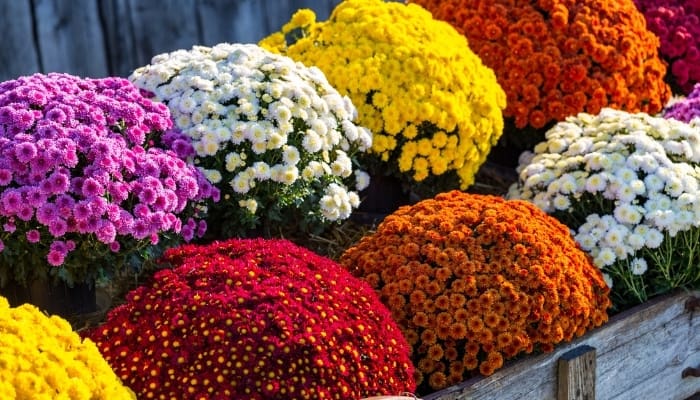Chrysanthemums, also known as mums, are stunning flowers that add brightness and an array of hues to any garden. Nevertheless, they are renowned for their slow blooming process and brief flowering period.
If you want to make mums bloom faster, you’ll have to take matters into your own hands with different strategies and techniques.
Supplies Needed
- High-nitrogen fertilizer (the 1st number on the bag)
- High-phosphorus fertilizer (the second number on the bag)
- Neem oil or rubbing alcohol
- Pruning shears
1. Provide Optimal Lighting
Like many flowering plants, mums need plenty of sunlight. Direct exposure is essential for the growth of the plant and the number of flowers it produces.
Before you plant the seeds or seedlings, choose a spot that gets between 6 and 8 hours of full sun every day. A west- or south-facing spot is ideal for the mums.
If you have potted mums indoors, then moving them to a window sill that gets plenty of sun should encourage the plants to bloom faster.
That said, make sure to move the plants with full blooms away from the afternoon sun since it could burn the flowers. In warm Hardiness Zones, partial shade is recommended to keep the flowers blooming for longer.
2. Maintain a Consistent Watering Schedule
Mums need about 1 inch of water a week before the flower buds emerge. Once the flowers open, the plant might need more watering, especially as the weather warms up and the soil dries fast.
Increase the weekly water quota to 2 or 3 inches accordingly. Don’t allow more than the top 1 inch of the soil to go dry between irrigations.
Potted mums tend to lose moisture faster than those growing in beds. So, water them 2-3 times a week until water flows out of the drainage holes in the pot.
Aim at the base of the plant, and water deeply to encourage the roots to grow deeper.
3. Fertilize Correctly
Start feeding mums after the threat of the last frost is over and the first signs of spring growth emerge. Use a high-nitrogen fertilizer (find it here at a great price) during this phase to encourage fuller foliage and robust root growth.
Once the first flower buds develop, switch to a high-phosphorus fertilizer (I recommend Scotts Super Bloom). Apply the fertilizer once every 2 weeks throughout the bloom season.
It’s generally recommended to stop fertilizing mums after July. Any new growth in the late summer could be damaged by the first frost. Supplement your feeding with organic compost or aged manure.
4. Eliminate Any Pest or Disease Issues
Mums attract pests, and such infestations can impact the plant’s flowering habits.
Aphids, thrips, earwigs, scales, leafminers, and mites are the most common pests that attack mums and cause late blooming problems.
Check on the mums regularly, looking for signs of pest infestations such as holes in the leaves or tiny dark spots left behind on the stems and underside of the leaves.
Use neem oil spray (I use Organic Neem Bliss)to treat all these pest infestations. You can also rub the stems and leaves with a swab soaked in rubbing alcohol not just to kill the pests but also to remove the trails of dark spots and gooey stuff on the plants.
Mums are also susceptible to botrytis, rust, root rot, stem rot, aster yellows, leaf spots, powdery mildew, and verticillium wilt.
Remove any infected plants to prevent the spread of the diseases. If potted plants are infected, dispose of the whole pot and the soil along with the mums, and start a new plant from scratch.
5. Cut Back Plants Early in the Season
Pruning is crucial for the success and flowering of perennials such as mums. Early in the season, pinch off the center leaves to encourage fuller foliage and bushy growth.
After the plant sheds its leaves in the early winter, cut it back to protect the roots against the freezing temperatures of the winter months.
When pruning, don’t remove any buds. Lost buds are hard to replace. Stop pruning two months before the first blooms. For fall bloomers, don’t prune the plant after July to encourage faster blooms.
6. Simulate Fall Conditions
If you’re growing mums indoors, you can help speed up their blooming by mimicking the fall conditions. This includes exposing the plants to shorter light hours and reducing the temperature at night.
This will trigger new flower buds and give you blooms ahead of the usual bloom season.

Tips for Buying Mums
- Choose the right mum varieties for your growing zone. Garden mums grow as perennials in Zones 5 to 9. Potted mums are more suited for cooler Grow Zones and are often grown as annuals.
- Select mums that have plenty of tight buds covering the stems. That’s a good indication that the plant will have an abundance of flowers when its bloom time. Plants that have few buds might not grow new buds later.
- Don’t buy a plant with open flowers. The flowers might die immediately after transplanting, and the plant won’t replace them until the next season.
- Look for hardy varieties that can handle the cold winters and changes in the weather without skipping a bloom season. Popular hardy mums include Pom Pom, Clara Curtis, Spider, Mary Stoker, Ruby Mound, Patriot, and Tripoli among others. Some of these are heirloom cultivars available only as seeds.
Best Time To Buy Mums
The best time to buy mums is in the early spring. If you’re starting them from seeds, plant the seeds in a seed tray 6 to 8 weeks before the last frost to give you a head start.
Once the soil is workable after the last frost, you can transplant the seedlings to a sunny and fertile spot in the garden.
For late bloomers, you can start them in the late summer to get blooms in the fall. However, that only works in Zones 8 and 9 where the first frost can be as late as November or December. For colder Zones 7 and below, plant mums in the early spring.
How Long Do Mums Last in the Fall?
Mums are known for their delayed blooming and small flowering window. On average, the flowers in the fall will only last about 3 weeks.
Once the flowers wither, pinch them off, and mulch around the base of the plants to protect them against freezing during the winter. Cut back the plant to conserve its resources and prevent damage to any new growth.
When Do Mums Die?
Although mums are perennials, the plant’s tolerance for cold winters diminishes every passing year. After about 3 to 4 years, the plant will eventually die off.
It’s worth noting that mums have a longer lifespan in warm regions compared to those growing in colder areas. Even those called “annual mums” are actually perennials, but the harsh conditions of the winter in the cold Growing Zones hasten their demise.
Conclusion
Mums are perennials flowers that take their time to bloom. However, you can speed up their blooming by watering them regularly, feeding them with the right fertilizer both before and after flowering, and ensuring that they’re getting 6 to 8 hours of full sun.
Since most mums bloom in the fall, simulating fall conditions of longer nights and cooler temperatures might encourage the plants to bloom faster.

